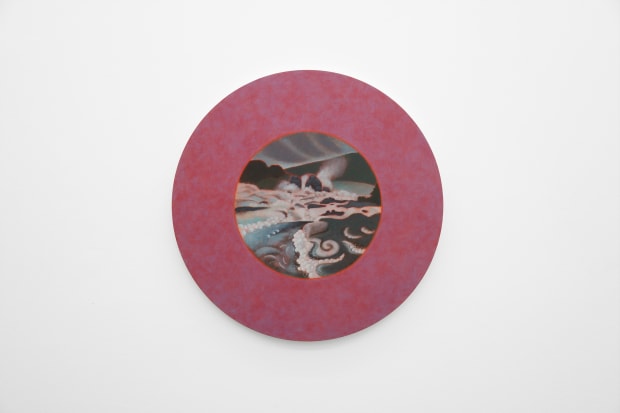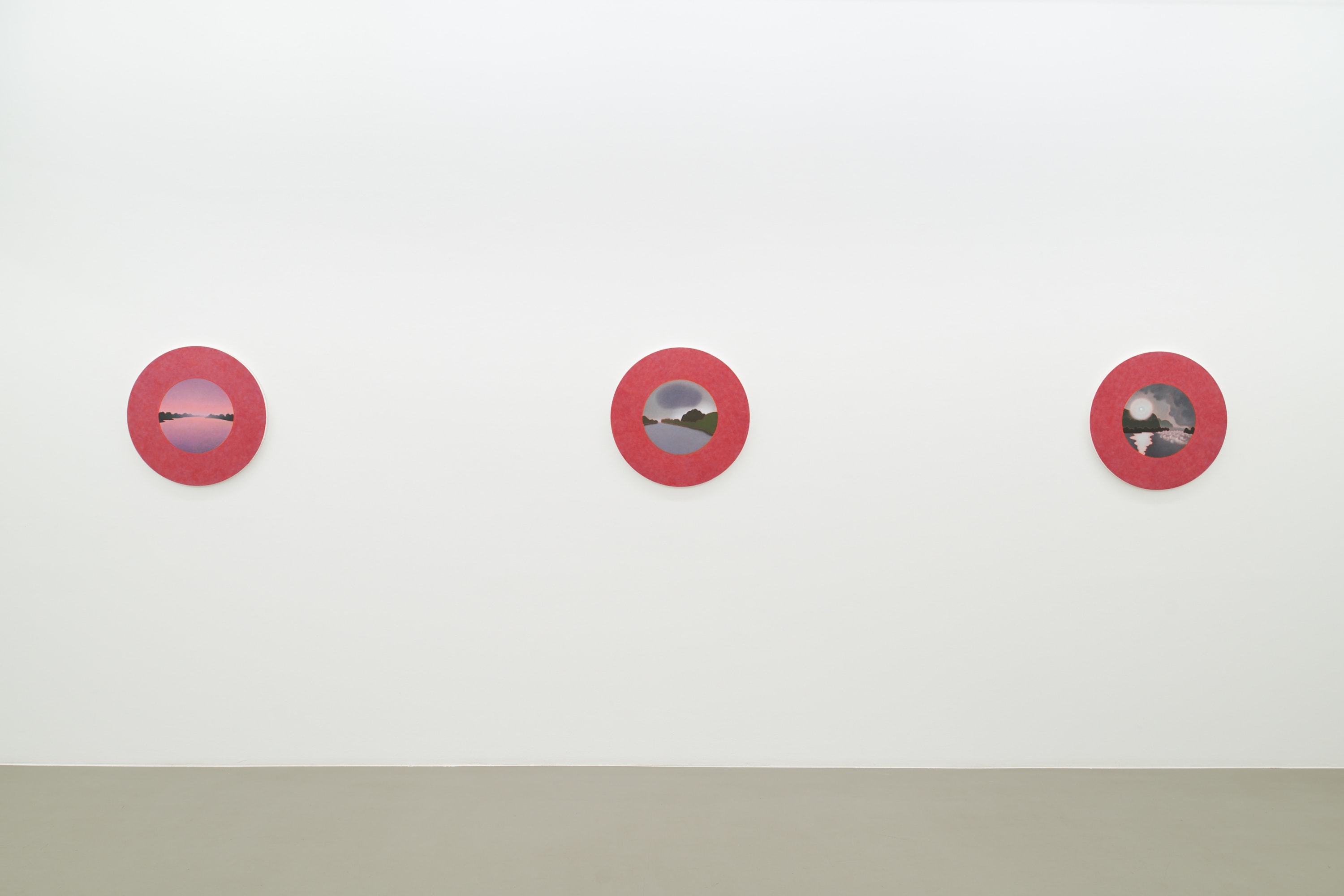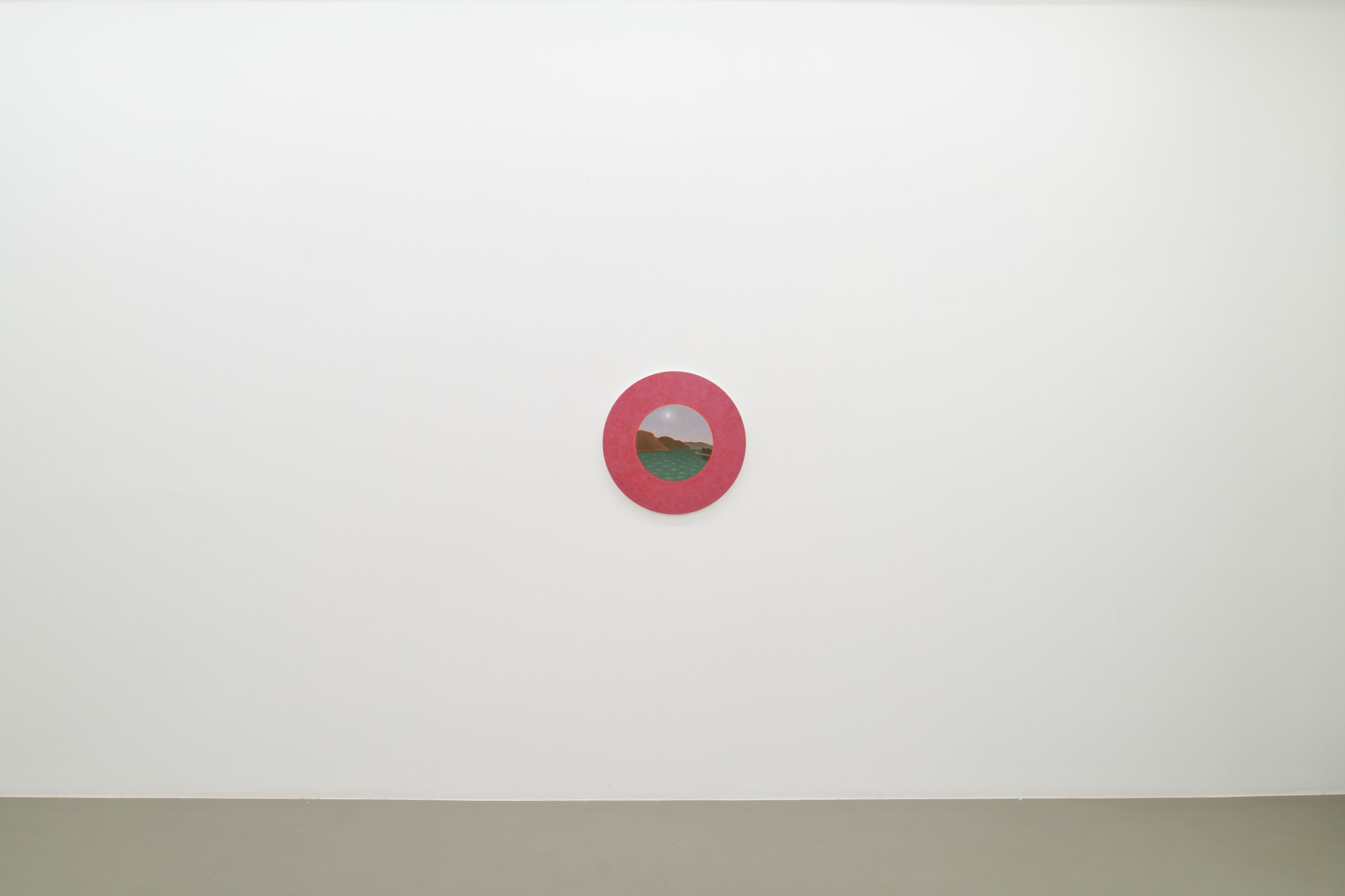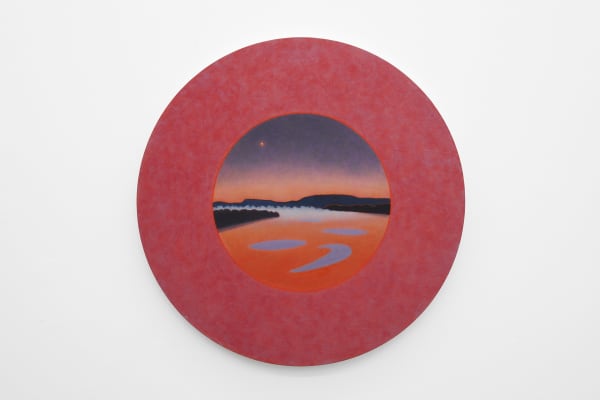-
-
For her Rhine series, Caroline Bachmann embarked on two journeys along the river - one shorter, one slightly longer. The latter was an eight-day boat trip along the Rhine from Basel to Rotterdam in October 2023. Two months later, she drove by car for almost four hours from her home in Cully on Lake Geneva to Reichenau in the Swiss canton of Graubünden, where the Vorderrhein and Hinterrhein rivers meet, to see the birthplace of the Alpine Rhine. If visitors begin their tour of the exhibition on the first floor of Meyer Riegger and then go down to the ground floor, they can also follow the course of the river from Reichenau to Rotterdam.
-
As if looking through the porthole of a ship, a telescope or a keyhole, Bachmann presents her depictions of the Rhine in round frames. One of the most famous round paintings is Michelangelo Buonarroti’s Tondo Doni (1505–06), a portrait of the Holy Family on display in the Uffizi Gallery in Florence. Like Michelangelo, Bachmann paints on wood. However, the diameter of her work is exactly half that of the Italian Renaissance painting – sixty centimetres. While there is only a hint of the landscape in the background of Michelangelo’s work, Bachmann’s paintings are entirely landscape. Although that in itself is nothing new, the decision to start painting landscapes in the 2000s, as Bachmann did, certainly required courage. Still, the question remains as to whether it is possible to add anything new to this art historical genre.
-
-
The artist’s method of working always remains the same: she begins by drawing quick pencil sketches outdoors and noting down the different colours and elements. During her trips along the Rhine, Bachmann produced around one hundred of these sketches; she then selected twenty-four and transformed them into paintings in her studio in Cully. While landscape painters such as Ferdinand Hodler and Giovanni Segantini always painted en plein air, namely in the open air, Bachmann prefers to retreat to her ‘cave’, as she refers to her studio. This separation from the original experience of nature – working in artificial light without a direct view of the landscape – is essential for Bachmann’s painting process, which is very slow. This way of working means that her paintings are characterised by different experiences of time: the swiftness of sketching gives way to the more laborious painting phase, during which the artist slowly resurrects the spontaneous encounter with nature that she experienced while sketching.
-
-
Bachmann’s paintings thus enable us viewers to experience time differently, too. Contrary to its usual linear course, the twenty-four-hour cycle of a day, Bachmann creates temporal connections in her works that are not chronological. She explains: “When it works, it’s as if the painting were suddenly dilating space and time and inviting us, as we stand face to face with it, to be part of all those times at the same time.”[2]
-
-
-
-
 Caroline Bachmann, Le Rhin I, 2024
Caroline Bachmann, Le Rhin I, 2024 -
 Caroline Bachmann, Le Rhin II, 2024
Caroline Bachmann, Le Rhin II, 2024 -
 Caroline Bachmann, Le Rhin III, 2024
Caroline Bachmann, Le Rhin III, 2024 -
 Caroline Bachmann, Le Rhin IV, 2024
Caroline Bachmann, Le Rhin IV, 2024
-
 Caroline Bachmann, Le Rhin V, 2024
Caroline Bachmann, Le Rhin V, 2024 -
 Caroline Bachmann, Le Rhin VI, 2024
Caroline Bachmann, Le Rhin VI, 2024 -
 Caroline Bachmann, Le Rhin VII, 2024
Caroline Bachmann, Le Rhin VII, 2024 -
 Caroline Bachmann, Le Rhin VIII, 2024
Caroline Bachmann, Le Rhin VIII, 2024
-
 Caroline Bachmann, Le Rhin IX, 2024
Caroline Bachmann, Le Rhin IX, 2024 -
 Caroline Bachmann, Le Rhin X, 2024
Caroline Bachmann, Le Rhin X, 2024 -
 Caroline Bachmann, Le Rhin XI, 2024
Caroline Bachmann, Le Rhin XI, 2024 -
 Caroline Bachmann, Le Rhin XII, 2024
Caroline Bachmann, Le Rhin XII, 2024
-
 Caroline Bachmann, Le Rhin XIII, 2024
Caroline Bachmann, Le Rhin XIII, 2024 -
 Caroline Bachmann, Le Rhin XIV, 2024
Caroline Bachmann, Le Rhin XIV, 2024 -
 Caroline Bachmann, Le Rhin XV, 2024
Caroline Bachmann, Le Rhin XV, 2024 -
 Caroline Bachmann, Le Rhin XVI, 2024
Caroline Bachmann, Le Rhin XVI, 2024
-
Caroline Bachmann, "Le Rhin": Meyer Riegger, Berlin
Past viewing_room
No images available.
























































